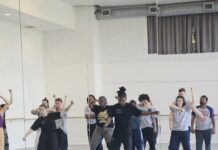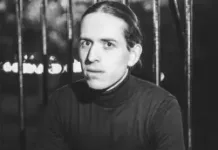
Limerick Post reporter Alan Jacques recently took a break from the hustle and bustle of modern life to join the Benedictine monks at Glenstal Abbey for some quiet prayer and contemplation.
by Alan Jacques

Glenstal Abbey in southeast County Limerick is such a place. Situated in the small picturesque village of Murroe, the popular beauty spot – 11 miles from Limerick City – is a little piece of heaven.
Home to a Benedictine community of 40 monks, aged between 33 and 90, this tranquil monastery offers sweet sanctuary away from the hustle and bustle of modern life.
With splendid unbroken views of the Galtee Mountains, Glenstal Abbey is an idyllic haven where life moves at its own steady pace. It is a place where nature and spirituality go hand in hand to weave an enchanting spell.
In fact, it’s just what the doctor ordered I tell myself as I pack my bag for an overnight stay at the monastery’s guesthouse. I’m at that point in the year where the annual holidays are looming, yet still seem frustratingly out of reach, so some refreshment of the soul seems just the ticket to tide me over.
I head out to Glenstal on one of the sunniest days of the summer. As I motor up the driveway I am instantly met by a multitude of vibrant flowers flitting in the breeze and ancient oak trees keeping watchful gaze over their bounty. The sunlight skirts flirtatiously on the pristine lake while the homecoming swallows’ jet at full throttle overhead.
I am struck by the miracle of nature and marvel in the knowledge that we have a little piece of paradise on our front doorsteps. The setting is picture postcard.
I can’t help thinking that heaven has a tough act to follow when the monks of Glenstal come a calling at the pearly gates.
Over the main archway to Glenstal Castle I am greeted by the word ‘PAX’, meaning peace. I stop and notice that the air is filled with a sense of serenity and at the same time, an underlying hum of activity.
The abbey is straight out of the pages of ‘Harry Potter’ and I half expect to bump into Ronald Weasley or Hermione Granger as they frantically attempt to solve some fantastical mystery or other. But Hogwarts this is not and so at 12pm I head straight to the chapel for daily Mass to commence my metaphysical cleanse.
Being an optimist, I find the church half full, and I am instantly intoxicated by the heady scent of incense. I count 21 monks during the concelebrated service in the simple chapel with striking green and blue ceiling and neo-baroque style pipe organ taking centre-stage at the back of the high altar.
I find the chanting and prayers spiritually rewarding and feel gently invigorated after my first treatment of the day. I then decide to take a leisurely stroll around the grounds of Glenstal to savour its true magnificence. A 500-acre estate complete with woodland paths, streams and lakes, it is as alive as it is beautiful.
During my ramble I meet visitors from as far and wide as Germany, Ennis and Kildare also taking in the abbey’s delights.

I pass strong-willed power-walkers along the pathways, two sleepy donkeys grazing on a plot of land and spry children kicking ball in the playing fields. I then head back to the guesthouse to settle in for my stay.
Surrounded by trees and nature, the Abbey Guesthouse offers a welcome retreat for visitors looking for time out from their busy lives. It is a quiet space offering time and space for rest, reading, reflection and prayer. Heaven indeed!
The guesthouse has 12 en-suite rooms, all with a view of the stunning gardens, library and church. I find my room modestly and simply furnished with a desk and chair and a good bed, which are more than adequate for my needs.
It is easy to see why President of Ireland, Michael D Higgins, a frequent visitor, has been so smitten with this County Limerick hideaway down the years.
The corridors are hushed as I leave for the visitor centre to meet with Benedictine monk Fr Simon Sleeman.
I find the Glenstal bursar, dressed in golfing sweater and slacks, an affable and talkative host. Responsible for the purse strings for the running of both the monastery and its fee-paying boarding school, he admits that he often finds himself awakened late at night with numbers running round his head.
“It is very challenging. The oil bill alone every year is €250,000,” Fr Sleeman explains.
“People forget, but we are a significant employer with over 100 staff that depend on us. It is a major balancing act to keep it running, but it is a well-managed house and we leave the rest to God.”
Last year pupil numbers rose to 218 at Glenstal Abbey, the highest in its 80-year history. Fees at the boarding school cost almost €18,000 for seven-day boarders and €10,250 for day boarders. In 2014 the school came second on the Sunday Times guide to Ireland’s 400 best schools, behind another Limerick school — Laurel Hill Colaiste FCJ.
In fact, the boarding school, which opened its doors to day students in 2012, was the top school in Munster for five out of the past 11 years and between 2011 and 2013 sent an average 88.3 per cent of its students to university.
“We have no secret ingredient like Coca Cola, it just happens,” the Glenstal bursar insists.
“The class sizes are small, no more than 20, and the students help each other. They learn from each other. I think that’s the key,” he suggests.
Fr Simon is good company. An open and friendly man, he seems happy for the opportunity to talk. He tells me a little of his own family history filled with adventures in far-flung corners of the globe and I am curious to learn how he became a man of the cloth.
As it turns out the 64-year-old had an epiphany the very first time he stood in the stone circle at the entrance to Glenstal Abbey in 1971.
“I felt an energy in my feet and thought here is an opportunity to find out what life means. There were possibilities here and I decided to give it a whirl.”
The Benedictine monks of Glenstal Abbey live their lives by the rule of St Benedict, putting the worship of God at the very centre of their every deed. Peace reigns within the walls of the monastery and Fr Sleeman points out that the structure of their day creates space and silence for God to be attended to.
“What is the hardest thing about life as a monk?” I ask.
“I often worry about becoming institutionalised and that I wouldn’t survive outside these walls. Your meals are provided for and the monastery is an oasis. I do have adventure in my blood,” he confesses.
I enjoyed my time in Fr Sleeman’s company and was sorry to take my leave of him.
Back outside I find myself drawn towards the church by the heavenly music of the pipe organ. In the eaves of its roof swallows have made their nests and flutter in time to the sounds of praise drifting through the walls. After a quick prayer I return to the visitor centre to check out the gift shop to pick up a copy of ‘The Rule of St Benedict’ as recommended to me by Fr Simon.
Two busloads of tourists have since arrived and one Benedictine friar is busy blessing rosary beads in the foyer. I find my pocket-sized read and have a quick browse around the buzzing store. If a bit of ecumenical shopping is your thing, then your prayers are answered! The gift shop sells everything from Glenstal Abbey apple brandy truffles to water fonts to holy medals, CDs and chocolate liqueurs.
Outside I meet with prior of the monastery, Fr Brendan Coffey, who is dressed in the traditional black habit. Originally from Ennis, he has called Glenstal home for the past 17 years. I suspect he is suspicious of the motive behind my article as he keeps his answers guarded, possibly to fend off any form of guttersnipe attack on the monastery. However, my intentions are good, fuelled only by curiosity and admiration, so decide not to make this any more painful for Fr Brendan than it appears and cut straight to the chase.
What is the hardest thing about being a monk?
“The other monks,” he replies with a smile.
It is now nearly 6pm and I’m still chuckling as I dash over to the church for Vespers. The evening prayers are in Latin and despite my total lack of understanding of the language, I find the service strangely stirring, creating an otherworldly soundscape for quiet contemplation and prayer.
Before supper I sit in the evening sunshine and read from ‘The Rule of St Benedict’. “The life of a monk ought to be a continuous Lent,” it advises in one passage.
Elsewhere St Benedict recommends that monks “refrain from grumbling”.
Tired students, after a day sitting Junior and Leaving Cert exams, start to appear around the grounds of the abbey recreating a brisk atmosphere as conjured up earlier by visiting tourists.
The sweat has been pouring off me all day and I’ve been curious to know how the monks survive the high temperatures in their black habits. I decide to find out. Heading into the abbey for food I meet Fr Lino from Portugal, who is working in Glenstal for one year, and ask about his garb.
“This is my winter habit, I have a lighter one. I’m from Southern Europe so this is not hot for me,” he tells me.
Supper in Glenstal Abbey is an experience that is sure to stay with me for the rest of my days. I am ushered with the other guests into the monastery refectory to join the monastic community for their evening meal.
It is a silent meal with the monks sitting at one end of the dining room and the mesmerised guesthouse visitors at the other. For the duration of the 15-20 minute sitting, the only person to speak is a velvet-toned monk who reads aloud from a book about the sheriffdoms of King Richard and the trials and tribulations of his tax-paying minions. It is all very surreal, and this monk, I think to myself, missed his calling as an RTE newsreader.
The food was simple but hearty fare. We were served liver and bacon with brown bread and jam and what I can only describe as buckets of tea. Tiredness has started to set in and I am grateful for the sustenance and the opportunity to sit in silence and rest and reflect on my day so far. Monks and guests sit in silence until the very last person has finished eating. Afterwards guests are lead back outside with much awkward bowing and jaws being picked up off the floor.
At 8.35pm it was back to the church for prayers before bedtime, which was also attended by the school’s exam students. Afterwards I spoke to a 33-year-old deacon from Tipperary staying in Glenstal’s hermitage retreat hut dubbed the “God-pod”. After ordination in a few weeks time, Vincent Kavanagh, fresh out of seminary in Maynooth College, will embark on a new life as a diocesan priest.
What did he make of the monastic experience?
“It has a draw for me. The whole idea of living a life of quiet that is conducive to prayer is very attractive,” Vincent told the Limerick Post on his third annual retreat at the abbey.
Matins and Lauds commence next morning at 6.35am so I decide to rest my weary head and turn in for the day. The bed is solid and not built for lazing around in but I am so tired that I go out like a light.
At 5.30 the next morning I am up with the birds chirping and the sun already grinning through my open window. I decide to forego coffee and cereal to have one last walk around the glorious grounds of Glenstal Abbey. At this early hour I have the walkways all to myself and I’m sorry not to be staying on a bit longer as I take in this beautiful dewy vista.
My visit was, sadly, nearing its end, which didn’t make the arduous morning prayers any easier. I was sorry too that I didn’t have that first hit of caffeine to jolt my system.
After one last hour of prayer and contemplation it was time to head back to the outside world with my newfound warm Ready Brek glow. The Benedictine order’s generous hospitality left me feeling refreshed and renewed and I hope it will not be too long before I visit them again.
“How beautiful heaven must be!” I think on my drive back into the city.
















